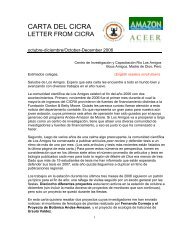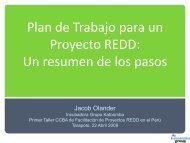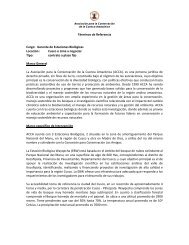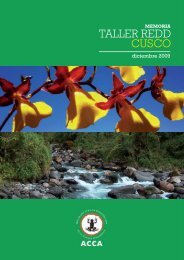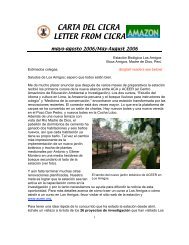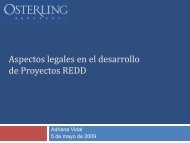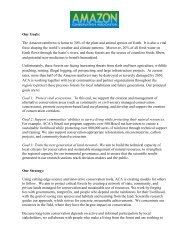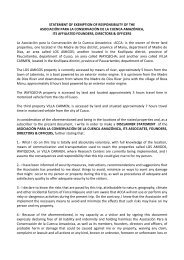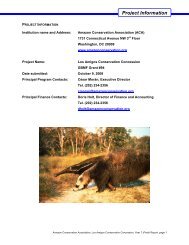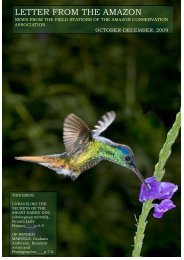LETTER FROM THE AMAZON - Amazon Conservation Association
LETTER FROM THE AMAZON - Amazon Conservation Association
LETTER FROM THE AMAZON - Amazon Conservation Association
Create successful ePaper yourself
Turn your PDF publications into a flip-book with our unique Google optimized e-Paper software.
Letter from the <strong>Amazon</strong> January-March, 2010<br />
The Raptors of CICRA<br />
While working as a field assistant for Ursula Valdez<br />
in 2004 and 2005, I noticed that the mining along<br />
the river Madre de Dios had almost tripled over the<br />
course of the year. Because the miners use<br />
mercury to extract gold from the sediment, I began<br />
to wonder about the presence of mercury in the<br />
area, and particularly its effect upon the wildlife.<br />
Because mercury bio-concentrates over the lifetime<br />
of an individual, and bio-magnifies in the food web,<br />
top predators like raptors are ideal for diagnosing<br />
and monitoring mercury contamination in the<br />
ecosystem. In August of 2006, along with my<br />
collaborator Juan Carlos Galvez, I began a study to<br />
measure and monitor mercury levels in the raptors<br />
of Los Amigos.<br />
Mercury is one of the most toxic substances on<br />
earth. It is a teratogen (causes birth defects), a<br />
mutagen (permanently changes genetic material), a<br />
carcinogen (causes cancer), and a neurotoxin<br />
(affects nerve tissue including the brain); it also<br />
causes blood chemistry and cytochemical changes.<br />
In birds, dietary mercury exposure can be directly<br />
lethal, or can have sub-lethal adverse effects on<br />
reproduction, growth and development, behavior,<br />
metabolism, and blood and tissue chemistry.<br />
In the field, we capture raptors using mist nets or<br />
Bal-Chatri (BC) traps and take blood and feather<br />
samples for mercury analysis. Feather sampling is<br />
an easy, non-invasive method of determining<br />
mercury levels because mercury is deposited in<br />
feathers as they grow. The concentration of<br />
mercury within the feather has a direct correlation<br />
with the individual’s mercury level. Samples are<br />
later analyzed at Clemson University.<br />
Roadside hawk (Buteo magnirostris); Margaret Shrum.<br />
5



